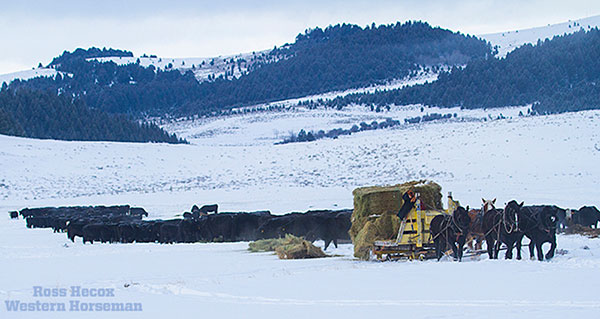It being January here in the rural Rocky Mountains at almost nine thousand feet up, it was cold: minus two degrees. Pure white snow lay upon the land at least three/five feet deep everywhere. Skies were crystal clear and blue. All the same, my wife and I were driving to town for our weekly run (60 miles roundtrip) for groceries. This is ranching country and, on the ranches we passed, herds of cattle were lining themselves up waiting for their farmer to deliver their morning feed.

Then we saw it: A farmer on his/her wagon, the wagon loaded with green hay moving slowly toward the cattle. A team of black horses was pulling that wagon. And shortly afterwards, on another ranch, two men on horseback were rounding up other cattle, probably also for their feed.
There are few places left in America, I thought, where one could see horses used in this old-fashioned way, so slow and deliberate.
And because I had been writing earlier in the morning—working on the beginning of a book—I mentally changed the subject and thought about narrative style, and its evolution, how say, Victorian novels start slowly, compared to novels written today. I suspect that the greatest influence is contemporary movies, (and television) with their fast, volatile opening action. I used to tease my youngest by saying that his idea of a good plot was “Five explosions connected by a chase.”
And I once received a letter from a girl which told me: “I read The True Confessions of Charlotte Doyle. It was boring at first but by the second page it got good.”
All art evolves, and in the modern world it seems to evolve faster. The novel is no exception. But I am struck with the need—I feel it myself—to inject stress, action, crisis, into the opening paragraph of a book. Even the First line. It’s not as if older works of fiction did not have urgency—consider the first chapter of Dickens’ Great Expectations. It surely has all of that.
Speaking for myself, Hammett, Hemingway, Chandler, Grahame, which I read as an adolescent (and still do), had a great impact on me. If I would cite the two most vital influences on my work, I would offer the contradictory pairing of the Victorian novel (for plot) and noir fiction (for dialogue).
What writers read they write. While I would urge would-be writers to read as widely as possible, I would urge them to write what they most enjoy reading. Never write what you think will sell. Always write what the heart loves. Ironically, that way you will be most self-critical of what you set down. You will be a better writer.
And if it is horses—so to speak—that pulls your novel into life—so be it. You will get there.
3 thoughts on “January in the Rockies”
I can just picture your drive to the store. The crunch of the snow, the horses’ steaming breaths, and the sun warming the scene. Thank you for letting it unfold so we could take in each morsel.
While I appreciate daily rituals, contemplative walks, and staring into a warming fire…I don’t seem to like my books starting this way. I’m guessing I need to know up front what I’m getting myself into, and I must be looking for an escape from my day-to-day.
When read-aloud books to my class start “slower” for their tastes, I sometimes need to remind my students to hang in there and build some understanding for what’s to come. They usually see the payoff, but I don’t know if they would have ventured into the book without another reader’s guidance. While it may sound superficial, what seems to beckon younger readers is the cover art, author’s book summary, and first page. And you are spot on to encourage writers to read widely and write what the heart loves. Good readers (even young ones) can feel the ring of authenticity crackle through the words.
Write on, my friend!
So so beautiful! I love the meaningful backdrop as it weaves its way into this piece.
Thank you for this. I too am told my stories begin slow and I the bulk of my reading are books that are about forty to a hundred and fifty years old.